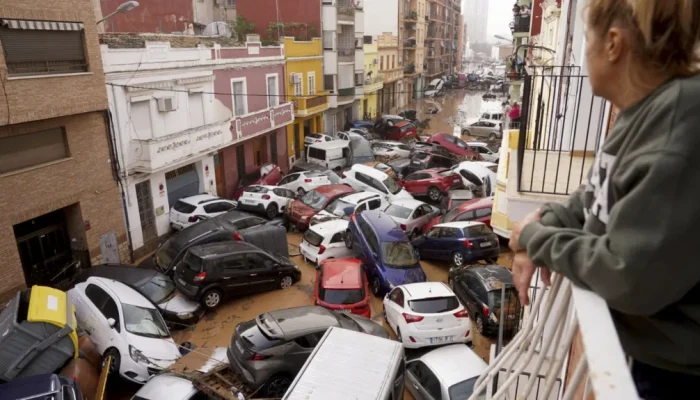Spain is reeling from one of its most catastrophic flooding events in decades, with the death toll expected to rise as torrential rains triggered devastating floods across the eastern province of Valencia and surrounding regions.
Already, at least 95 people have been confirmed dead, with dozens more reported missing. The situation has been described as Spain’s worst flood disaster since 1973, and the impact has been staggering: entire neighborhoods have been submerged, buildings washed away, and roads turned into rivers as residents struggle to navigate the flooded landscape.
The deluge began on Tuesday when intense rainfall brought a year’s worth of water to some areas in just eight hours. This abrupt onset of torrential rain led to flash floods that wreaked havoc on urban and rural areas, sweeping away cars, blocking roads, and trapping residents in their homes. The sudden floods caught many off-guard, forcing residents to seek shelter on roofs, cling to trees, or even form human chains to escape the rising waters.
The Spanish government, under Prime Minister Pedro Sánchez, has declared three days of national mourning. In a heartfelt address, Sánchez expressed solidarity with the flood victims, pledging full support for recovery and urging citizens to remain vigilant as extreme weather conditions persist.
The message resonated across Spain as citizens witnessed the scale of the disaster unfolding in real-time. The government has mobilized over 1,000 military personnel and emergency responders to aid in rescue and recovery operations. However, the sheer magnitude of the disaster has complicated efforts, with many areas still inaccessible due to flooded roads and downed power lines.
Stories of Survival Amid Devastation:
Residents have shared harrowing accounts of survival as the floodwaters surged. In Valencia, young Guillermo Serrano Pérez recounted the terrifying moment the floodwater surged down a highway “like a tsunami,” forcing him and his parents to abandon their car and seek higher ground. Others on the road had little choice but to form a human chain, clinging to one another for stability as they inched toward safety. For many, the fear of slipping and being swept away was palpable.
In nearby towns, some residents reported that water levels rose over a meter within minutes, leaving little time for those trapped to escape. Emergency crews worked tirelessly to airlift individuals stranded on rooftops and balconies while other rescue workers, in boats and on foot, attempted to reach isolated areas despite the treacherous conditions. Community members in Chiva, one of the towns hardest hit, reported that some neighborhoods were already submerged when official alerts were issued, raising questions about the timing and effectiveness of emergency warnings.
Contributing Factors and the Role of Climate Change:
Meteorologists attribute the heavy rainfall primarily to a “gota fría” – a seasonal weather phenomenon that occurs when cold air from northern Europe meets warmer Mediterranean waters, causing sudden downpours. However, scientists have pointed to climate change as a significant factor intensifying the scale of such extreme weather events. Dr. Friederike Otto, a climate researcher, explained that a warmer atmosphere can retain more moisture, leading to increasingly severe bursts of rainfall. With the global temperature now approximately 1.1°C higher than in pre-industrial times, the chances of intense rain events like these are heightened, underscoring the broader implications of climate change for weather patterns worldwide.
Spain has experienced its share of natural disasters, but recent years have seen a notable increase in the frequency and intensity of such events. Many researchers believe this uptick correlates with rising global temperatures. As warming trends continue, experts warn that Spain—and indeed the rest of the world—may face even more devastating natural disasters.
Ongoing Response and International Aid:
In the wake of this disaster, Spain’s government has pledged long-term support for the affected regions. Meanwhile, European neighbors have offered assistance, and the Copernicus satellite system has been activated to help coordinate rescue operations. As the rain shifts north toward Catalonia, emergency services remain on high alert, with weather warnings in place across other parts of Spain. Preparations are underway to respond to further potential flooding, as authorities prioritize the safety and welfare of affected communities.




